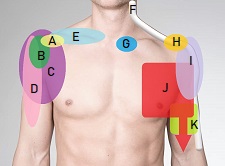- Home
- Common Shoulder Problems
- Swimmers Shoulder
Swimmers Shoulder
Written By: Chloe Wilson BSc (Hons) Physiotherapy
Reviewed By: SPE Medical Review Board
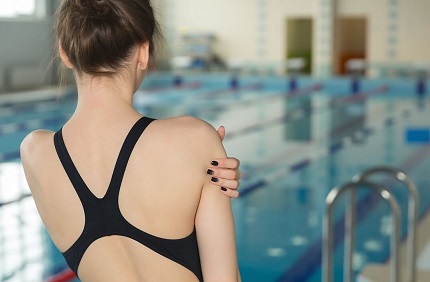
Swimmers shoulder is the most common injury seen in swimmers.
The shoulder is the most mobile joint in the whole body but also the least stable.
The repetitive use of the shoulder joint in swimming leads to irritation, inflammation, tears and scarring. This causes pain, weakness and impedes function.
Swimmers shoulder particularly affects swimmers who do freestyle (front crawl) and butterfly. The shoulder is working having to work really hard against resistance in a compromised position which makes it prone to injury. So it’s no wonder that 90% of injuries seen in swimmers are at the shoulder.
Here we will look at what swimmers shoulder is, what causes it, why it’s so common, how it is diagnosed, the best treatment options and how to prevent it.
Shoulder Anatomy
In order to understand what is going on with Swimmers Shoulder, it helps to know a bit about how the different structures in and around the shoulder fit together.
The shoulder complex is the most mobile joint system in the entire body allowing the largest range of motion in multiple directions. There are actually four joints in the shoulder complex:
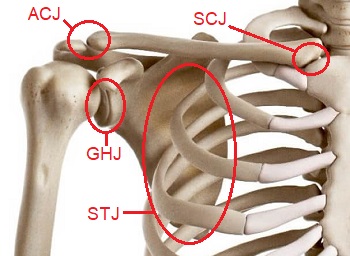
- Glenohumeral Joint: between the upper arm and shoulder blade
- Acromioclavicular Joint: between the collar bone and the shoulder blade
- Sternoclavicular Joint: between the collar bone and the breast bone
- Scapulothoracic Joint: between the shoulder blade and the ribcage
Most of the mobility at the shoulder comes from the glenohumeral joint, a ball and socket joint comprising of the:
- Humeral Head: the hemispherical ball at the top of the upper arm bone
- Glenoid Fossa/Cavity: the shallow socket on the side of the shoulder blade
There is little bony stability at the glenohumeral joint which allows for the huge range of motion, so it relies on stability from a complex network of soft tissues:
- Joint Capsule & Shoulder Ligaments: surround the joint to hold it together, think of them like rubber bands
- Glenoid Labrum: a special ring of cartilage that deepens the socket to improve the grip on the humeral head
- Muscles & Tendons: the rotator cuff and biceps tendons reinforce the capsule and labrum and the muscles are strong dynamic stabilisers. The scapular stabilizing muscles also control shoulder blade movement for increased shoulder stability
At the top of the shoulder is an area known as the subacromial space, an area between the humeral head and the acromion – the bony projection at the top of the shoulder blade. A number of soft tissues pass through the subacromial space including the rotator cuff, biceps tendon and bursa.
Swimmers shoulder develops when any one, or more, of these structures are overworked, irritated or injured.
What Is Swimmers Shoulder?
Swimmers shoulder is a common injury in swimmers where the shoulder is aggravated by frequent, repetitive strain through the shoulder.
The term swimmers shoulder actually refers to a number of different shoulder pathologies including:
- Impingement Syndrome: Where there is narrowing of the subacromial space
- Rotator Cuff Injuries: inflammation and/or wear and tear of the rotator cuff tendons resulting in tendonitis or rotator cuff tears
- Labrum Injuries: tearing of the special cartilage that lines the shoulder socket
- Bursitis: inflammation of the small sacs that sit between the bones and soft tissues to reduce friction
- Shoulder Instability: from ligamentous laxity or muscle imbalance that causes the humeral head to shift forwards and up which reduces the subacromial space.
Swimmers shoulder is usually multifactorial and there are often two or more of these pathologies affecting the shoulder at the same time.
Common Causes
Swimmers shoulder develops when there is excessive pressure, friction and force through the shoulder complex from:
- Overuse: Over-training without adequate rest in-between sessions to give the tissues time to recover. This is particularly common in swimmers with high stroke counts. Sudden increases in training time or distance also increases the risk of developing swimmers shoulder
- Poor Technique: incorrect technique such as dropping the elbow or inadequate body roll puts the shoulder into the wrong position, increasing the risk of swimmers shoulder
- Muscle Imbalance: swimmers are prone to having overactive adductors and internal rotators, weak external rotators and scapular stabilizers, and tight pecs. These contribute to shoulder instability, putting the shoulder joint slightly out of place which increases the risk of swimmers shoulder
- Tight Joint Capsule: swimmers often have a tight posterior joint capsule and lax anterior capsule which shift the humeral head out of place
- Abnormal Acromion Shape: reduces the subacromial space
- Thoracic Stiffness: tightness and stiffness in the thoracic spine can impede shoulder movement
- Fatigue: As the rotator cuff and scapular stabilising muscles tire there may be excessive movement at the humeral head and reduced scapular rotation and protraction. This decreases the subacromial space and increases the tensile stress and compression on the tendons which leads to swimmers shoulder
- Unhelpful Training Methods: using paddles, pull buoys and drag suits can place the shoulder under too much strain
Swimmers shoulder is usually caused by a combination of two or more of these factors, any of which can lead to shoulder instability. The humeral head migrates anteriorly and superiorly which narrows the subacromial space causing irritation, inflammation and impingement.
Why Is Swimmers Shoulder So Common?
Swimmers shoulder affects anywhere from 40-90% of swimmers at some point. The action of swimming requires repetitive overhead movement patterns with the shoulders in an adducted, internally rotated position. Not only dues this reduce the subacromial space, it also impedes the blood flow to the rotator cuff and biceps tendons.
The main propulsive force when swimming comes from the shoulders to propel the body against the resistance of water with approximately 90% of the driving force coming from the shoulders.
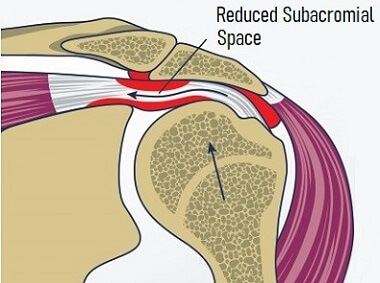
Elite level swimmers will train once or twice a day, 5-7 days a week and will often clock around 9-12 miles per day.
That’s around 3500 strokes per arm, per day. So, it’s no wonder that 90% of all injuries in swimmers are shoulder injuries.
This repetitive rotation motion is asking a lot of the shoulder complex and is compounded by any weakness, tightness, instability or improper positioning which will place excess pressure, friction and pinching on the soft tissues in the subacromial space.
This causes irritation which leads to inflammation, microtrauma and tearing in the soft tissues resulting in pain and stiffness at the shoulder – swimmers shoulder!
Common Symptoms
The symptoms of swimmers shoulder tend to build up gradually over time and may include:
- Shoulder Pain: diffuse pain and aching which gets progressively worse with training. The pain tends to be deep rather than superficial and may be felt in different places at different times e.g. the front of the shoulder during the “catch phase” (as the hand goes into the water and starts to pull back) or at the back of the shoulder during the “recovery phase” (as the arm lifts out of the water)
- Weakness: and fatigue especially in the rotator cuff muscles. Common signs of weakness seen when swimming are that the swimmers elbow starts to drop down as they swim, the pull through phase in the water is shortened to avoid pain from impingement, or there is a loss of speed and pace
- Joint Laxity: which causes shoulder instability
- Shoulder Stiffness: range of motion might be limited, particularly shoulder flexion and abduction above head height
- Clicking: you may notice a clicking or grinding sensation in the shoulder when lifting it above head height due to instability
The symptoms of swimmers shoulder will vary from person to person depending on which structures are damaged, and the extent of the injury.
Diagnosing Swimmers Shoulder
You doctor or physical therapist should be able to diagnose swimmers shoulder from talking to you and looking at your shoulder. They will do a physical examination looking at your shoulder movements, scapular positioning at rest and during movement, muscle strength and joint laxity.

Your doctor will also carry out some swimmers shoulder tests such as:
- Shoulder Instability Tests: e.g. Sulcus sign and apprehension/relocation tests
- Shoulder Impingement Tests: Hawkins Kennedy
- Joint Laxity Testing: for widespread hypermobility
They may also send you for X-rays to identify any bone problems or a CT scan or MRI to evaluate the soft tissues.
Swimmers Shoulder Treatment
Treatment for swimmers shoulder should be started as soon as possible to reduce the amount of damage and to speed-up healing. In most cases, conservative treatment (non-operative) is sufficient.
#CommissionsEarned from Amazon on qualifying purchases
Swimmers shoulder treatment will involve a combination of:
- Reduce Training: it may be sufficient to temporarily reduce training levels (distance and frequency), change strokes or stick to leg work, but in some cases you may need to stop training altogether for a few days. It can help to use swim fins (special flippers) to enhance leg propulsion and reduce the stress on the shoulders
- Ice: after training for 10-15 mins and regularly in between sessions, every couple of hours. You can get specially designed shoulder ice packs which strap in place so you can move around while icing the shoulder
- Medication: pain relief e.g. paracetamol/Tylenol and anti-inflammatories e.g. ibuprofen/Advil
- Physical Therapy: ultrasound, deep transverse friction massage aka cross friction massage, rehab programme, joint mobilisations to stretch the posterior joint capsule
- Corticosteroid Injections: reduce pain and inflammation, but be aware they can temporarily weaken the shoulder
- Rotator Cuff Strengthening: exercises to strengthen the rotator cuff are a really important part of swimmers shoulder treatment. You may start with isometric rotator cuff exercises where you work the muscles without moving the shoulder, and progress on to using resistance bands. There should be special emphasis on infraspinatus and teres minor training. Ideally you want to be doing swimmers shoulder exercises that keep the shoulder below 90 degrees flexion and abduction so as not to aggravate things
- Scapular Stabilizing Exercises: Improving scapulohumeral rhythm – how the shoulder blade moves has a big impact onto the position of your shoulder. Almost everyone with swimmers shoulder would benefit from doing regular scapular stabilization exercises
- Posterior Capsule Stretches: Stretches for swimmers shoulder tend to focus on the posterior capsule which is usually tight. One way to do this is to bring your arm across your chest and draw your elbow to the opposite shoulder. Hold this position for 30 seconds and repeat 3 times
- Core Stability Training: Improving the core stability helps your body to function better as a unit and will help improve shoulder positioning and action. Pilates taught be a physical therapist is a great way to improve core stability
- Check Your Stroke Technique: particularly important is body roll and elbow position – your elbow should be above your hand when out of the water (recovery phase) and as hand enters water (catch phase). Get your coach to check your arm and body position and you might want to get them to video you so you can see what’s going on too
Surgery For Swimmers Shoulder
While most cases of swimmer shoulder will heal without the need for surgery, if symptoms fail to settle after 3-6 months of treatment or if scans reveal impingement is linked to the presence of bone spurs, then surgery may be advised.
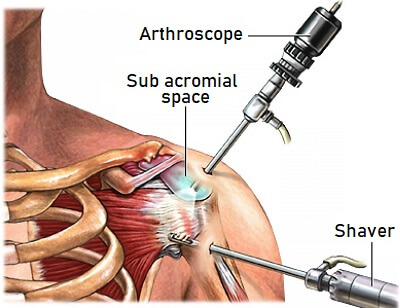
Swimmers shoulder surgery involves a Subacromial Decompression.
This is arthroscopic (keyhole) surgery to remove any inflamed tissues and bone spurs in order to increase the subacromial space.
This may be combined with capsular plication or inferior capsule shift if capsule laxity is causing multidirectional instability.
If there is any damage to the glenoid labrum, that can be repaired at the same time.
You can find out all about what happens during surgery and how to make a great recovery in the Subacromial Decompression Surgery section.
How To Prevent Swimmers Shoulder
Prevention is always better than cure so here are my top tips for avoiding swimmers shoulder:
- Check Your Technique: expert analysis of training methods and stroke mechanics is the best way to avoid swimmers shoulder
- Don’t Over-Train: Allow adequate rest between training sessions and make sure you don’t increase you training schedule too fast. Follow the 10% rule – increase training by no more than 10% per week, whether that’s time, pace, resistance or distance etc.
- Vary Training Sessions: it’s not just about training in the pool! Fitness and strength work can be done out of the pool without putting the shoulder into vulnerable positions
- Warm Up & Cool Down: warming up your body, muscles and heart raises body temperature and increases blood flow to the muscles which improves their ability to contract and expand. Cooling down helps relax the muscles, returns the heart rate to normal and helps get rid of lactic acid
- Avoid: pull sets, paddles and drag suits as they make the shoulder work even harder than it already is. Do try wearing swim fins
- Stretches: shoulder stretches and upper back stretches should be part of your training regime, particularly targeting the pecs, lat dorsi and the posterior capsule
- Strengthening Exercises: Strengthening the rotator cuff muscles, particularly infraspinatus and teres minor, and the scapular stabilizers is one of the best ways to avoid swimmers shoulder
- Listen To Your Body: If it hurts, stop! Don’t push through the pain, you’ll only make it worse
What Else Can Help?
Swimmers shoulder is a collective term for a number of pathologies that affect swimmers including impingement syndrome, bursitis, rotator cuff tears, tendonitis and shoulder instability.
Remember, the shoulder is an extremely mobile joint but it is inherently unstable. Swimming puts the shoulder under the greatest stress of pretty much any sport. Prevention is better than cure so if you are a swimmer, make sure you are looking after your shoulders.
Don’t over-train and check your technique, make rotator cuff strengthening and scapular stabilization exercises part of your training regime and listen to your body. Swimmers shoulder stretches and upper back stretches can also really help.
Other swimmers shoulder treatment options include physical therapy, ice, medication, steroid injections and working on stroke technique.
Most cases of swimmers shoulder will settle down in 6-12 weeks with these treatment methods, but if symptoms persist, subacromial decompression surgery may be advised.
You may also be interested in:
Related Articles
Medical & Scientific References
- Sports Health Journal: Epidemiology of Injuries and Prevention Strategies in Competitive Swimmers
- National Library Of Medicine: Swimmer's Shoulder
- North American Journal Of Sports Physical Therapy: Prevention and Treatment of Swimmer's Shoulder
Page Last Updated: May 21st, 2024
Next Review Due: May 21st, 2026

